This website uses cookies so that we can provide you with the best user experience possible. Cookie information is stored in your browser and performs functions such as recognising you when you return to our website and helping our team to understand which sections of the website you find most interesting and useful.
db Eats: Yong Yi Ting, Mandarin Oriental
Douglas Blyde walks through a forest of 70,000 mosaic tiles to the recently reopened Yong Yi Ting restaurant in Shanghai, where he experiences a “Negroni-scented” tea and “the best red wine in China”.
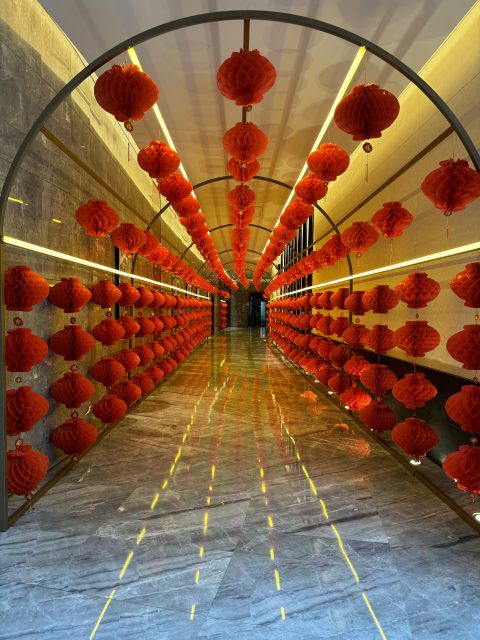
“This tastefully furnished restaurant comes with lush garden views and a charming water terrace,” praised Michelin of Yong Yi Ting, which has retained a star since the guide arrived in China in 2017, while Fodor’s described the experience of dining here as “nothing less than exquisite…”
Design
Turning eleven in May, the five-star tower overlooks the Huangpu River and its misty, leafy promenade. Art defines interiors, with 3,500 works from 4,000 tailored to the setting, including the floor-to-ceiling “Sound of Heaven” in the lobby. This Sino-Japanese entente is best viewed through the lens of a mobile phone, whereby the 70,000 mosaic tiles form a tropical forest. The atrium also features the hotel’s logo: a century-old fan. Originally crafted in Hong Kong for prosperous Europeans, it features 100 figures, each clinching its own fan.
The presidential suite is the largest in this most populous city in China, running across half the footprint of the 25th floor. At 788 square metres, it was occupied by the exclusive beauty brand Clé de Peau on our visit. Beyond porcelain panels by artist Lai DeQuan, accommodation features two private gardens.
Having reopened in January post a refurbishment, which unfortunately closed the view of the handsome cellar, Yong Yi Ting unfolds with a spacious foyer festooned with “lucky” lanterns, according to restaurant manager Yani Wang. Here, guests are welcomed with tactile cups of Negroni-scented pu erh tea. This leads to one of seven private dining rooms with a prow-like balcony, then the main restaurant, where silk voiles separate tables overlooking the courtyard.
Drinks
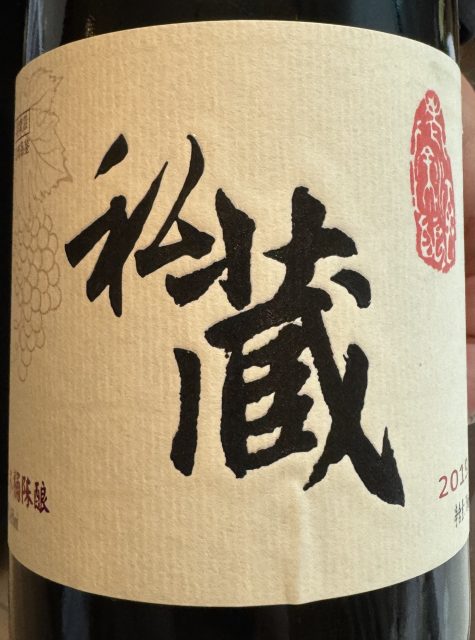
The director of food and beverage, Philipp Stieger oversees wines. Born to an English mother and Austrian father, Stieger served in the Austrian armed forces for five years before starting a hospitality career. An early role saw him work as a bartender at Buddha Bar in Austria, before he began to explore his fascination for wine at The Stafford, London. Here, under the affirmative tutelage of master sommelier, Gino Nardella, Stieger’s “world changed over six months.” His Asian odyssey commenced when he became a trainee manager at Kempinski Dalian.
He went on to manage VUE (RIP) at Hyatt on the Bund, Shanghai, which boasted 738 bins. He later became operations manager at Hyatt Bangkok – a city he recently re-visited as part of his commitment to the Chaîne des Rôtisseurs to commemorate the society’s half-century in Thailand. With Langham Hospitality Group, he was the director of food and beverage in Guangzhou. Interim postings took him back to Austria, then Croatia, Serbia, and Montenegro. He finally became food and beverage director at Mandarin Oriental, Shanghai, in October 2023, where he promptly revamped the wine selection.
Options by the glass range from non-alcoholic “Bla” Copenhagen sparkling tea, which Stieger thoughtfully poured as an opening toast for our booking, given it included an appreciative six-year-old gastronome, to Gaja’s popular Ca’Marcanda Promis, with fizz by Ferrari. By the bottle, other sparklers include Deutz 2010, Dom Pérignon Rosé 2005, and 1999 Mumm Cuvée R. Lalou, described by Gifford’s guide as a “digestif” Champagne.
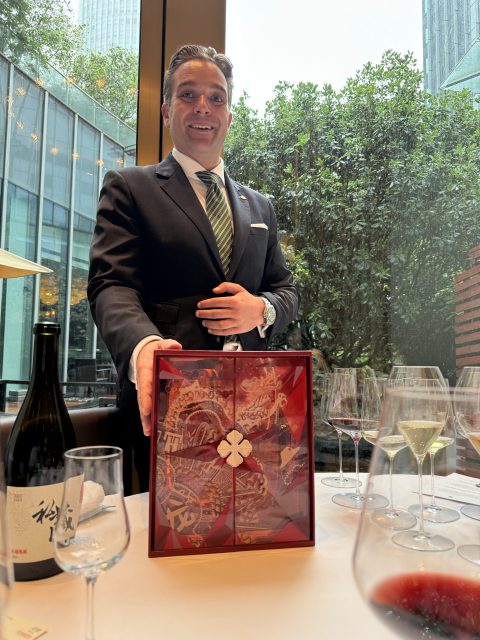
Although well-heeled diners in China seem to favour younger whites, gloriously aged bottles include Château-Grillet, reaped from a mere 8.6 acres, and the seemingly indefatigable Domaine de Chevalier Blanc, both from 2006, as well as Jermann’s “Where Dreams have no end “Chardonnay (2008). Reds with sway include Ornellaia 2018, Mouton 1989, Petrus 2006, Ausone 1999, and the “flamboyant” according to Robert Parker, 1990 Canon-la-Gaffelière.
Interesting bin ends encompass luxurious Cahors Malbec, Château de Haute-Serre Geron Dadine de Haute-Serre Cuvée Prestige which basks in the benefits of nearly two and a half decades of age (2000) and is offered at a tempting price, 1989 Don Melchor Cabernet Sauvignon from Chile, and, taking the name of its owner, the 7ft 6in basketball ace, Yao Ming Reserve 2014 from Napa.
Sweeties include a 2009 Seifried Sweet Agnes from New Zealand’s Nelson, and Château d’Yquem 1995.
Maintained pristinely, the glassware is part of Spiegelau‘s Sommelier series.
Dishes
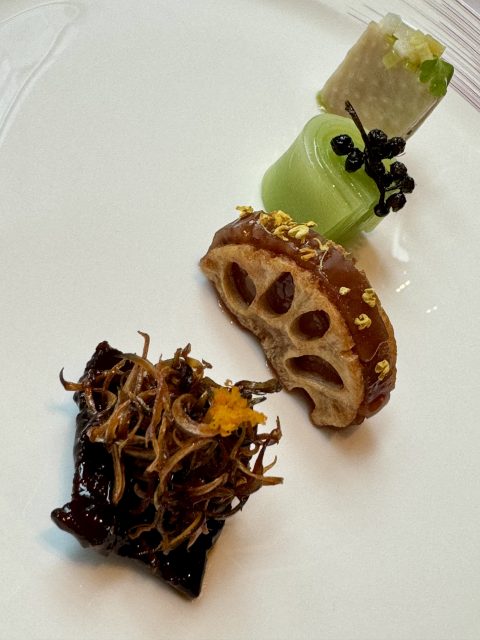
Served on custom Legle porcelain, Hangzhou cuisine is prettily mastered by consultant chef, Fu Yueliang. Replete with breakdowns of signature dishes etched onto the walls, Yueliang’s famed mothership restaurant, Ru Yuan, is located on a former golf driving range in that city.
Overseen by chef Wu Rongbai, today’s lunch opened with jade-coloured, lightly pickled broccoli stems, perfectly setting the tone for the precise, ingredient-forward procession of plates to come.
While he considered pouring Champagne with a quartet of appetisers, Stieger opted for the gentle, rather than enraging, 5% ABV of a second Copenhagen sparkling tea blend, this time comprising Lady Grey and Earl Grey. Meticulously presented and tender, the Zhejiang chicken thigh sandwich was enlivened by spring onion, ginger, and garlic, while a millefeuille arch of outdoor-grown asparagus marinated in and topped with crisped Rattan pepper brought out the peach notes of the tea. Young, crunchy lotus root was topped with an older version, combined with glutinous rice, and adorned with Osmanthus flowers. The final appetiser was the most powerful: well-spiced, curled, dried beef on sliced, Yunnan Mushroom.
Cradled in a bains-marie, a subtle, clear chicken broth featured a handmade fish dumpling and our second encounter in this country with the delightfully bright, dewy Hangzhou peas. With this, Stieger headed further South into Europe. From the latest vintage available in China, the slightly pétillant 2022 Kamptal Grüner Veltliner from Weingut Bründlmayer was overseen by Andreas Wickhoff – “the first Austrian Master of Wine”, said Stieger. Having considered Riesling, though not having access to one in China which would be “sufficiently dry”, Stieger praised the Grüner for leaving a residue of its flavour on the palate long after the dish culminated.
The main courses provided Stieger with multiple matching opportunities. Evoking cuttlefish in appearance, glossy, braised yellow fish stomach cooked in pork bone stock, with crisped rice and dried scallop seasoning, “could have worked with a restrained Pinot Noir given its dark sauce,” said Stieger, though the best pairing was found in the hotel’s own collaboration wine from China’s Puchang Vineyard, in Turpan Valley, Xinjiang. With almost a decade of age (2015), it blossomed quickly in the glass.
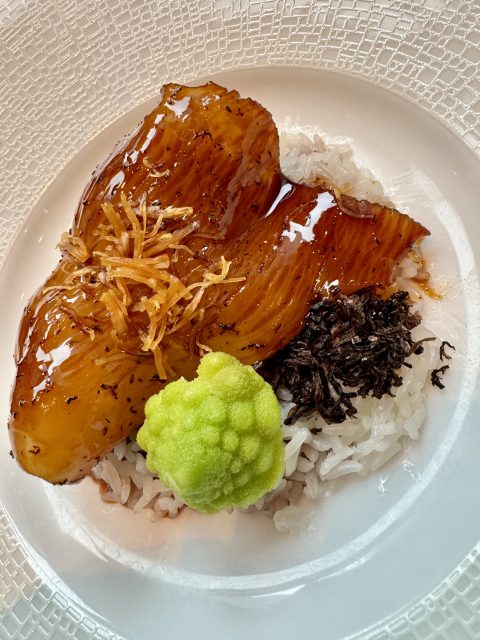
Stieger chose Alois Lageder’s rose gold-coloured 2022 Pinot Gris to accompany lightly sautéed small river shrimps next, with tea leaf-shaped and infused Longjing pasta shapes. When pepped with ginger and vinegar, Terras Gauda’s strapping Albariño from the same vintage, sourced from his Spanish wine-importing friend, Alberto at “Pasion Beijing,” had more richness and tension so as not to get eclipsed with this version of the dish. Stieger noted this importer also has access to such rarities as 1946 Don PX sherry.
Formed into a pagoda-like shape, we enjoyed packing fan-shaped pumpkin bao with braised five-spice pork belly and dried bamboo shoots, paired with one of Stieger’s personal bottles. From 2019, Si Cang is a finespun blend of Cabernet Sauvignon, Marselan, and Merlot from Helan Mountain. “I think it’s the best red in China,” said Stieger of the exotic sandalwood and lapsang souchong-scented wine, adding, “it shows the winemaker’s experience.”
Evoking a chatterbox in appearance, one dim sum dish featured four-fortune-pocketed encapsulations of wood ear mushrooms, egg yolk, carrot, and celery, while a crescent-shaped steamed dumpling contained shredded, peppery pork, just visible beyond its translucent rice flour mantel.
Crème brûlée, a pudding beloved, it seems, by chefs in China who Michelin and the Black Pearl guides rate, was scented with Longjing tea, and gutsily paired with the off-dry 2019 Domaine Saint Remy, Gewürztraminer from Alsatian producer, Rosenberg.
We ended with a dram from one of 6,000 bottles of violet-scented, Camus Extra Le Voyage du Dragon Limited Edition Cognac. The fifth-generation producer, Cyril, “is based in Shanghai,” noted Stieger, who had kindly shared this personal bottle with us. Paying tribute to the 60th anniversary of diplomatic relations between China and France, the bottle featured a golden origami dragon by French artist Gwendoline Finaz de Villaine. Camus, the holder of the Legion d’Honneur, is also launching a whisky distillery in China, said Stieger. Called GUQI, the project, in partnership with Gujinggong, the fourth largest producer of baijiu in China, is under construction in Anhui province.
Last Word
Thankfully, our last meal of consequence in China proved to be its most refined, uplifting, and carefully matched. Another Mandarin Oriental and a Landmark Hotel will rise in the West Bund in 2027 in Shanghai, a megalopolis so substantial its skyscrapers eerily pierce the clouds, though based on today’s performance, the serene Yong Yi Ting will continue to magnetise a discerning clientele who value careful culinary tailoring over ostentation.
Best for:
- Older vintages
- The care of food and beverage director, Philipp Stieger
- Private dining room with circular kitchen for xiao long bao masterclass
Related news
Sarah Heller MW wins Asia Personality Award 2024
Crown Jewels: how Church Road is putting Hawke's Bay on the fine wine map

